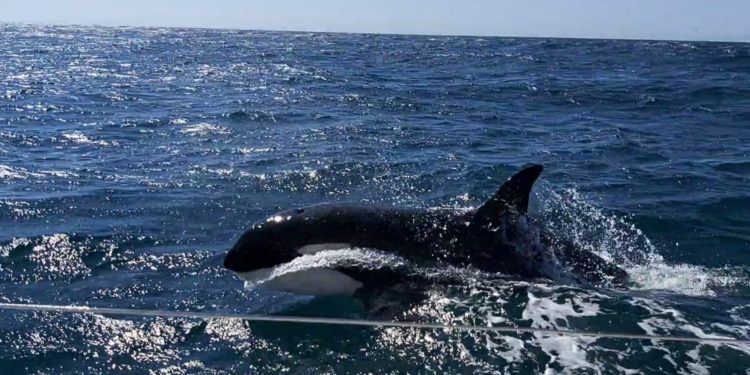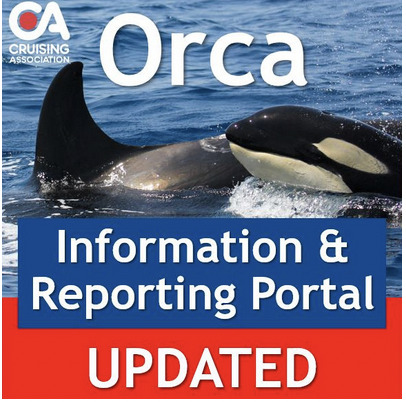Straits of Gibraltar: Vessel Sinks After Damage from Orca Interaction
A pod of orca, identified as “Gladis”, has caused the loss of a sailing yacht in Moroccan waters in the southern Straits of Gibraltar. This is the first yacht to sink after an orca interaction this year, but the 5th yacht to date. All crew were rescued.
Published 6 months ago
Hull Ruptured After Orca Interaction
Two crew members aboard the yacht Alboran Cognac sent out an SOS distress call on Sunday May 12, 2024 at 0900 local time (0700 GMT), when a pod of orcas attacked their rudder, the Spanish Coast Guard reported.
The crew sounded the alarm when the orca rammed the hull and rudder with one blow, rupturing the hull and creating a serious situation.
The Moroccan maritime authorities instructed the Alboran Cognac crew to put on life jackets and activate their AIS (Automatic Identification System), as the boat started taking on water. A coast guard helicopter was scrambled and a nearby tanker MT Lascaux diverted to pick up the crew from the stricken yacht, which later sank.
This is the first vessel that has sunk following orca meddling with the rudder this year, according to Spain’s Maritime Rescue organisation. The Alboran Cognac encountered the cetaceans 14 miles from Cape Spartel, at the southern entrance to the Strait of Gibraltar, in Moroccan waters.

Experts suspect “Gladis” group of Orca
Experts who study the behavior of the cetaceans in these waters believe that behind this new incident are a group of Iberian killer whales known as Gladis, 15 specimens of a population of about 37 that live between the north of the Iberian Peninsula and the Strait of Gibraltar.
The first documented event of this type occurred in May 2020 and, with this latest incident, seven vessels have already been lost – five sailboats and two Moroccan fishing boats, the latter of which were in very poor condition.
Clashes occur mainly on the Atlantic coast of the Iberian Peninsula, but also in adjacent areas of France and Morocco. It is the migratory route of these cetaceans, which follow tuna, their main source of food. The latest data from the Atlantic Orca Working Group (GTOA) , an organization that contributes to its conservation and management, indicate that at least 673 interactions have occurred (when the orcas approach the boat with or without contact), since the Gladis began with their unusual behavior.
Scientists from GTOA maintain that these are not intentional attacks, but rather a learned behavior that may be related to their curiosity, environmental stimulation or some form of caution that leads them to want to stop the boat.
“They are not going like a battering ram to attack the ship and sink it and they could do so if that were their intention,” says Alfredo López, marine biologist and GTOA spokesperson.
Although there is no pattern and their way of acting varies, they usually approach the boat stealthily, often without the crew noticing, to position themselves under the boat. Then they begin to touch it and hit the rudder with their heads, so that they can break it by using leverage. “A leak can even occur, and sailboats do not usually have adequate pumps to evacuate the amount of water that enters, so the boat can sink,” explains López.
Library of Reports and Interactions
Since the launch of its orca project in June 2022, the Cruising Association (CA) says it has received around 150 reports from skippers who have experienced an orca interaction.
The CA has now created a library of comments extracted from the full interaction reports, categorising the different actions and measures that skippers have reported when attempting to deter or end an interaction.


What to do if the Orca approach
Spain’s Ministry of Transport offers recommendations on its website for navigation through the area delimited on a map that they attach in the Gulf of Cádiz and the Strait of Gibraltar. These are measures to follow throughout the year, but especially between the months of April and August, when more interactions occur, and whenever possible and do not generate greater danger. First of all, they point out, you must avoid navigating through the area delimited on a map and, if you do, get as close to the coast as possible, within safety limits.
If an encounter is unavoidable, it is best not to stop the boat (whether motorized or sailing) and head towards the coast, to shallower waters. Deterrent measures should not be used that could cause death, damage, inconvenience or concern to the whales, for example, by shooting flares at them, as has already happened on some occasions. Captains should immediately notify the sighting or interaction with cetaceans to the nearest Rescue Coordination Center through VHF channels (channel 16 or working channel).
Noonsite collaborated with the Cruising Association on a series of useful articles to help skippers transiting this area to prepare for the possiblity of encountering orca:
- Noonsite – Passage Planning for the Atlantic Iberian Peninsula
………………………………
Related News:
- Orca Sink Another Yacht in Gibraltar (Marine Industry News)
- Orcas “Attack” and Sink Another Yacht in the Strait of Gibraltar (Yachting Monthly)
- The Gladiard Orcas Attack Again and Sink a 15m Sailboat (DiariodePonteVedra)
………………………………
Related Links:
- Spain’s Ministry of Transport Orca Advice
- Noonsite Cruising Resources – Orcas and Yachts (inc. previous news)
………………………………
Noonsite has not independently verified this information.
………………………………
Find out all news, reports, links and comments posted on Noonsite, plus cruising information from around the world, by subscribing to our FREE monthly newsletter. Go to https://www.noonsite.com/newsletter/.
Related to following destinations: Atlantic Coast (Morocco), Gibraltar, Gibraltar Port, Morocco, South West Coast (Spain), Spain
Related to the following Cruising Resources: Atlantic Ocean East, Incident Reports, Mediterranean, Orcas and Yachts, Safety






